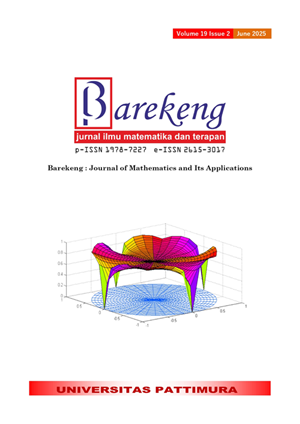PRICING EMPLOYEE STOCK OPTION USING TRINOMIAL TREE METHOD
Abstract
This study explores the Employee Stock Option (ESO) model proposed by Liao and Lyuu, which provides a robust framework for addressing critical factors such as dilution, early exercise, and employee forfeiture rates. The model is solved using the trinomial tree method, allowing for the consideration of three possible stock price movements: increase, unchanged, or decrease. This approach combines forward and backward calculations to accurately evaluate ESO values by accounting for the complex interactions of these parameters. Dilution effects are modeled by adjusting stock prices based on outstanding shares and strike prices, while early exercise probabilities are addressed using a modified Chi-Square distribution to represent employee behavior. Additionally, the forfeiture rate is dynamically adjusted based on ESO returns and the ratio of stock-to-strike prices. The analysis reveals that ESO price negatively correlates with strike price and forfeiture rate, whereas parameters such as vesting time, maturity date, risk-free rate, volatility, and the number of ESOs granted exhibit positive correlations. This comprehensive methodology demonstrates the practical applicability of the Liao and Lyuu model for real-world ESO valuation. By integrating these critical factors into a unified framework, the study contributes significantly to the literature on financial modeling and provides actionable insights for companies seeking to optimize their ESO programs.
Downloads
References
N. M. W. Menawati and I. B. P. Astika, “PENGARUH RENTABILITAS DAN LIKUIDITAS PADA JUMLAH OPSI SAHAM DAN DAMPAKNYA PADA NILAI PERUSAHAAN,” E-Jurnal Akuntansi Universitas Udayana, vol. 18, no. 3, pp. 1915–1942, 2017.
N. Gusnela and D. Ahmad, “PENENTUAN NILAI OPSI SAHAM KARYAWAN (OSK) DENGAN MEMPERHITUNGKAN EFEK DILUSI MENGGUNAKAN METODE LATTICE TRINOMIAL,” UNP Journal of Mathematics, vol. 3, no. 1, pp. 48–52, 2020.
F. J. Fabozzi and P. P. Peterson, FINANCIAL MANAGEMENT AND ANALYSIS SECOND EDITION, Second. New Jersey: John wiley & Sons, Inc., 2013.
E. Wahyuni, R. Lestari, and M. Syafwan, “MODEL BLACK-SCHOLES OPSI CALL DAN OPSI PUT TIPE EROPA DENGAN DIVIDEN PADA KEADAAN CONSTANT MARKET,” Jurnal Matematika UNAND, vol. 6, no. 2, pp. 43–49, 2017.
S. N. Hayuningrum and R. Artiono, “PEMODELAN MATEMATIKA OPSI SAHAM KARYAWAN MENGGUNAKAN METODE BINOMIAN ENHANCED AMERICAN,” MATHunesa: Jurnal Ilmiah Matematika, vol. 11, no. 2, pp. 186–191, 2023.
M. Athar, “EMPLOYEE STOCK OPTION PLANS: A META-ANALYSIS (UNDERSTANDING IMPACT OF ESOPS THROUGH LITERATURE),” STUDIES IN BUSINESS AND ECONOMICS, vol. 15, no. 1, pp. 100–114, Apr. 2020, doi: 10.2478/sbe-2020-0009.
E. Chendra, L. Chin, and A. Sukmana, “PRICING EMPLOYEE STOCK OPTIONS (ESOS) WITH RANDOM LATTICE,” IOP Conf Ser Mater Sci Eng, vol. 335, p. 012041, Apr. 2018, doi: 10.1088/1757-899X/335/1/012041.
M.-C. Wu, I.-C. Lin, and Y.-T. Huang, “MANAGING EMPLOYEE STOCK OPTION EXPENSE: A FAIR VALUE APPROACH,” Australian Accounting Review, vol. 26, no. 79, pp. 429–438, 2016.
J. Hull, Options, FUTURES AND OTHER DERIVATIVES, 11th ed. New York: Pearson, 2022.
E. Rahmi, “TRINOMIAL MODEL ON EMPLOYEE STOCK OPTION VALUE,” IOSR-JM, vol. 13, no. 5, pp. 23–28, 2017.
F. Y. Liao and Y. D. Lyuu, “AN EXPANDED MODEL FOR THE VALUATION OF EMPLOYEE STOCKS OPTIONS,” The Journal of Futures Markets, vol. 29, no. 8, pp. 713–735, 2009.
A. Fitri and Suherman, “PENENTUAN NILSI OPSI SAHAM KARYAWAN (OSK) DENGAN MEMPERHITUNGKAN EFEK DILUSI DENGAN MENGGUNAKAN METODE BLACK-SCHOLES,” UNPjoMath , vol. 3, no. 2, pp. 7–11, 2020.
H. Maulana and K. A. Sidarto, “VALUING EMPLOYEE STOCK OPTION (ESO) UNDER EMPLOYEE FORFEITURE RATE,” in The International Confrence on Mathematics, Science, Education and Technology,” Faculty of Mathematics and Sciences, Universitas Negeri Padang, 2015, pp. 71–77.
V. Rosalina, “PEMODELAN MATEMATIKA OPSI SAHAM KARYAWAN MENGGUNAKAN METODE TRINOMIAL YANG MEMPERHITUNGKAN EFEK DILUSI,” Jurnal Ilmiah Matematika, vol. 11, no. 2, pp. 192–198, 2023.
K. K. Langat, J. I. Mwaniki, and G. K. Kiprop, “PRICING OPTION USING TRINOMIAL LATTICE METHOD,” Journal of Finance and Economics, vol. 7, no. 3, pp. 81–87, 2019.
J. Lee, J.-R. Chang, L.-J. Kao, and C.-F. Lee, ESSENTIALS OF EXCEL VBA, PYTHON, AND R: FINANCIAL DERIVATIVES, RISK MANAGEMENT AND MACHINE LEARNING, 2nd ed., vol. 2. 2023.
R. Meliyani, E. H. Nugrahani, and D. C. Lesmana, “PENENTUAN HARGA OPSI CALL WINDOW RESET MENGGUNAKAN METODE BINOMIAL TREE DAN TRINOMIAL TREE,” Journal of Mathematics and Its Applications, vol. 11, no. 2, pp. 192–198, 2023.
Copyright (c) 2025 Donny Citra Lesmana, Reza Tri Ahmad Ramadhan, Siti Nurjanah, Vanaya Syahira Dharmawan

This work is licensed under a Creative Commons Attribution-ShareAlike 4.0 International License.
Authors who publish with this Journal agree to the following terms:
- Author retain copyright and grant the journal right of first publication with the work simultaneously licensed under a creative commons attribution license that allow others to share the work within an acknowledgement of the work’s authorship and initial publication of this journal.
- Authors are able to enter into separate, additional contractual arrangement for the non-exclusive distribution of the journal’s published version of the work (e.g. acknowledgement of its initial publication in this journal).
- Authors are permitted and encouraged to post their work online (e.g. in institutional repositories or on their websites) prior to and during the submission process, as it can lead to productive exchanges, as well as earlier and greater citation of published works.






1.gif)



